2019 Hyundai Nexo cruise control
[x] Cancel search: cruise controlPage 381 of 560
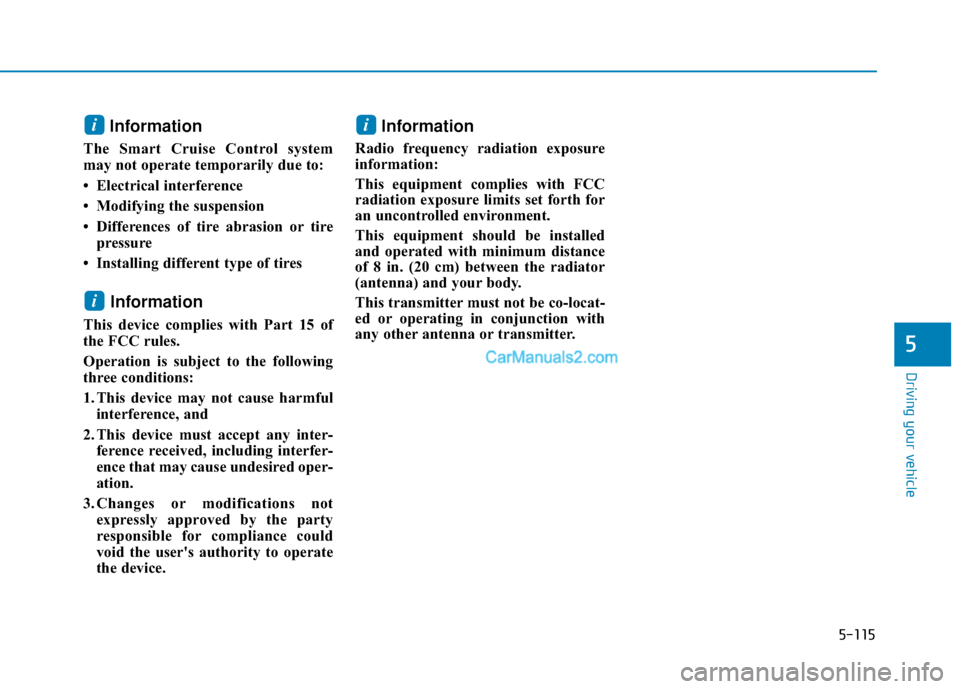
5-115
Driving your vehicle
Information
The Smart Cruise Control system
may not operate temporarily due to:
• Electrical interference
• Modifying the suspension
• Differences of tire abrasion or tirepressure
• Installing different type of tires
Information
This device complies with Part 15 of
the FCC rules.
Operation is subject to the following
three conditions:
1. This device may not cause harmful interference, and
2. This device must accept any inter- ference received, including interfer-
ence that may cause undesired oper-
ation.
3. Changes or modifications not expressly approved by the party
responsible for compliance could
void the user's authority to operate
the device.
Information
Radio frequency radiation exposure
information:
This equipment complies with FCC
radiation exposure limits set forth for
an uncontrolled environment.
This equipment should be installed
and operated with minimum distance
of 8 in. (20 cm) between the radiator
(antenna) and your body.
This transmitter must not be co-locat-
ed or operating in conjunction with
any other antenna or transmitter.
i
i
i
5
Page 382 of 560

5-116
Driving your vehicle
L
LE
E A
A D
DI
IN
N G
G
V
V E
EH
H I
IC
C L
LE
E
D
D E
EP
P A
A R
RT
TU
U R
RE
E
A
A L
LE
E R
R T
T
(
( I
IF
F
E
E Q
Q U
UI
IP
P P
PE
ED
D )
)
The Leading Vehicle Departure Alert
system alerts the driver of the depar-
ture of the vehicle in front when the
vehicle is stopped and the Smart
Cruise Control (SCC) system is in
activation.System Setting and Activation
System setting
With the vehicle ON, the Leading
Vehicle Departure Alert system turns
on and gets ready to be activated
when the 'vehicle Settings → Driver
Assistance →Driving Assist →
Leading vehicle departure alert' is
selected selected in the AVN screen
display. The system stops operation
when the setting is deactivated.
However, if the vehicle is turned off
then on again, the system maintains
the previous state.
System standby
While the Smart Cruise Control
(SCC) system is in operation, your
vehicle stops behind the vehicle in
front when it stops. The message is
displayed on the cluster within 3 sec-
onds after the stop and the system
will be in the standby position.
OFE058180L
Page 383 of 560
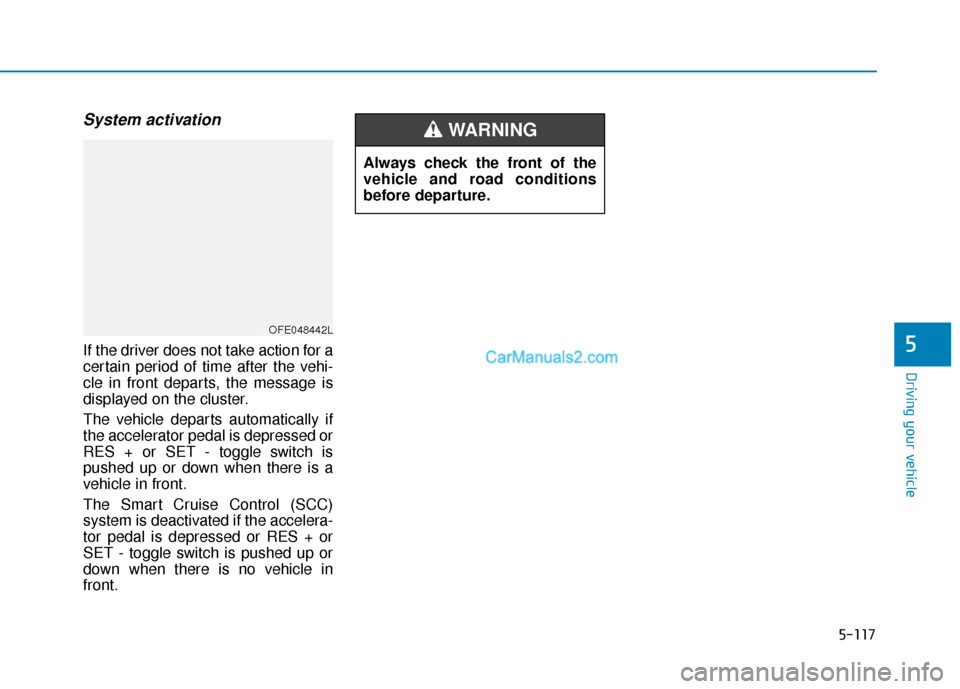
5-117
Driving your vehicle
5
System activation
If the driver does not take action for a
certain period of time after the vehi-
cle in front departs, the message is
displayed on the cluster.
The vehicle departs automatically if
the accelerator pedal is depressed or
RES + or SET - toggle switch is
pushed up or down when there is a
vehicle in front.
The Smart Cruise Control (SCC)
system is deactivated if the accelera-
tor pedal is depressed or RES + or
SET - toggle switch is pushed up or
down when there is no vehicle in
front.
OFE048442L
Always check the front of the
vehicle and road conditions
before departure.
WARNING
Page 385 of 560
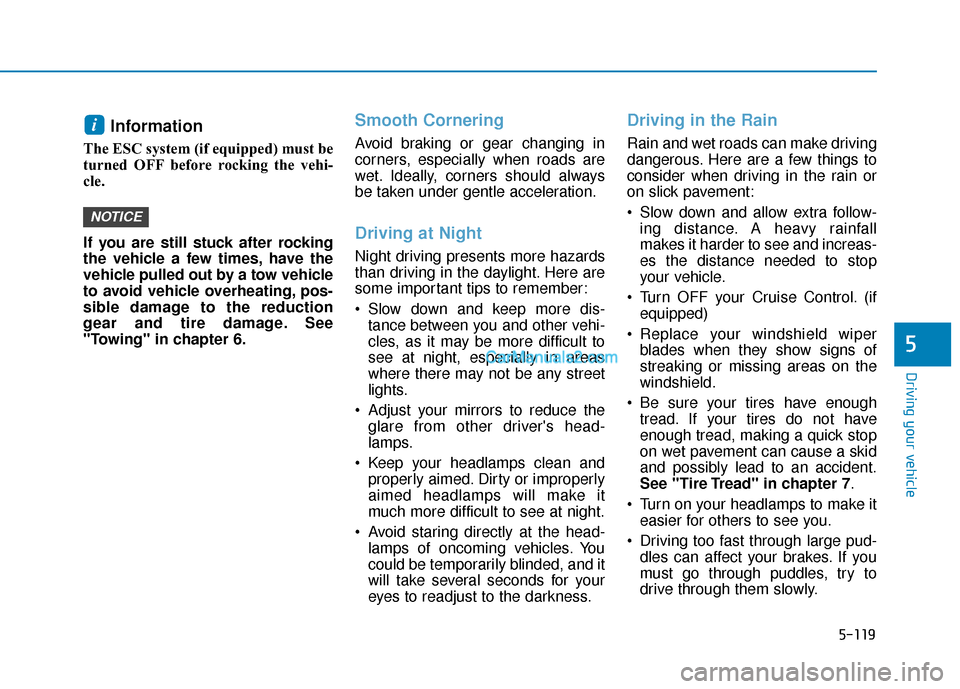
5-119
Driving your vehicle
5
Information
The ESC system (if equipped) must be
turned OFF before rocking the vehi-
cle.
If you are still stuck after rocking
the vehicle a few times, have the
vehicle pulled out by a tow vehicle
to avoid vehicle overheating, pos-
sible damage to the reduction
gear and tire damage. See
"Towing" in chapter 6.
Smooth Cornering
Avoid braking or gear changing in
corners, especially when roads are
wet. Ideally, corners should always
be taken under gentle acceleration.
Driving at Night
Night driving presents more hazards
than driving in the daylight. Here are
some important tips to remember:
Slow down and keep more dis-tance between you and other vehi-
cles, as it may be more difficult to
see at night, especially in areas
where there may not be any street
lights.
Adjust your mirrors to reduce the glare from other driver's head-
lamps.
Keep your headlamps clean and properly aimed. Dirty or improperly
aimed headlamps will make it
much more difficult to see at night.
Avoid staring directly at the head- lamps of oncoming vehicles. You
could be temporarily blinded, and it
will take several seconds for your
eyes to readjust to the darkness.
Driving in the Rain
Rain and wet roads can make driving
dangerous. Here are a few things to
consider when driving in the rain or
on slick pavement:
Slow down and allow extra follow-ing distance. A heavy rainfall
makes it harder to see and increas-
es the distance needed to stop
your vehicle.
Turn OFF your Cruise Control. (if equipped)
Replace your windshield wiper blades when they show signs of
streaking or missing areas on the
windshield.
Be sure your tires have enough tread. If your tires do not have
enough tread, making a quick stop
on wet pavement can cause a skid
and possibly lead to an accident.
See "Tire Tread" in chapter 7.
Turn on your headlamps to make it easier for others to see you.
Driving too fast through large pud- dles can affect your brakes. If you
must go through puddles, try to
drive through them slowly.
NOTICE
i
Page 557 of 560
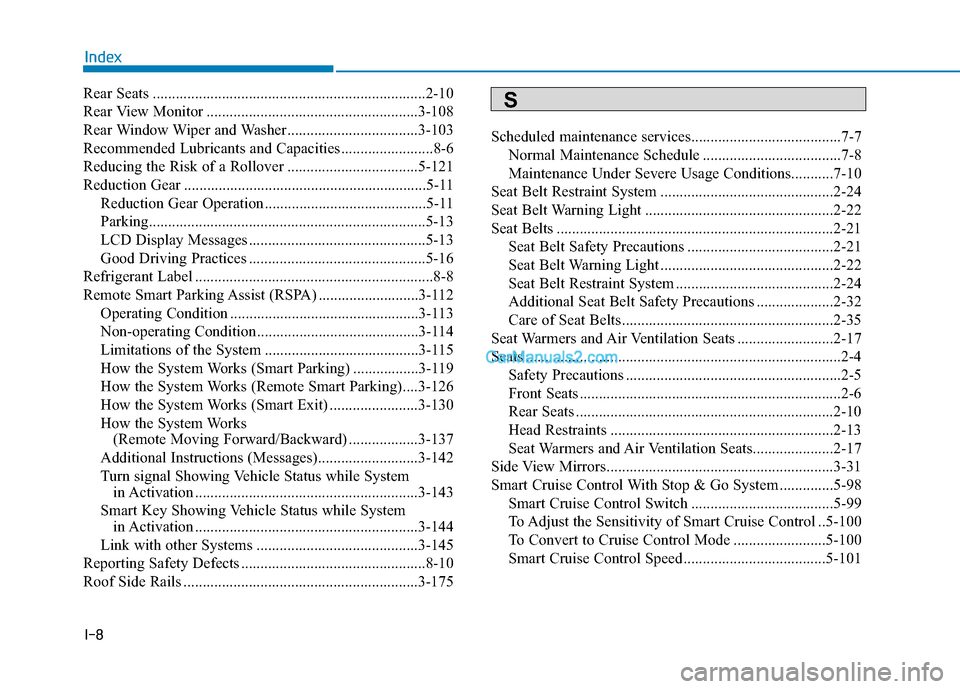
I-8
Rear Seats .......................................................................2\
-10
Rear View Monitor .......................................................3-108
Rear Window Wiper and Washer..................................3-103
Recommended Lubricants and Capacities ........................8-6
Reducing the Risk of a Rollover ..................................5-121
Reduction Gear ...............................................................5-11Reduction Gear Operation ..........................................5-11
Parking........................................................................\
5-13
LCD Display Messages ..............................................5-13
Good Driving Practices ..............................................5-16
Refrigerant Label ..............................................................8-8
Remote Smart Parking Assist (RSPA) ..........................3-112 Operating Condition .................................................3-113
Non-operating Condition ..........................................3-114
Limitations of the System ........................................3-115
How the System Works (Smart Parking) .................3-119
How the System Works (Remote Smart Parking)....3-126
How the System Works (Smart Exit) .......................3-130
How the System Works (Remote Moving Forward/Backward) ..................3-137
Additional Instructions (Messages)..........................3-142
Turn signal Showing Vehicle Status while System in Activation ..........................................................3-143
Smart Key Showing Vehicle Status while System in Activation ..........................................................3-144
Link with other Systems ..........................................3-145
Reporting Safety Defects ................................................8-10
Roof Side Rails .............................................................3-175 Scheduled maintenance services.......................................7-7
Normal Maintenance Schedule ....................................7-8
Maintenance Under Severe Usage Conditions...........7-10
Seat Belt Restraint System .............................................2-24
Seat Belt Warning Light .................................................2-22
Seat Belts ........................................................................\
2-21 Seat Belt Safety Precautions ......................................2-21
Seat Belt Warning Light .............................................2-22
Seat Belt Restraint System .........................................2-24
Additional Seat Belt Safety Precautions ....................2-32
Care of Seat Belts .......................................................2-35
Seat Warmers and Air Ventilation Seats .........................2-17
Seats ........................................................................\
..........2-4 Safety Precautions ........................................................2-5
Front Seats ....................................................................2-6
Rear Seats ...................................................................2-10
Head Restraints ..........................................................2-13
Seat Warmers and Air Ventilation Seats.....................2-17
Side View Mirrors...........................................................3-31
Smart Cruise Control With Stop & Go System ..............5-98 Smart Cruise Control Switch .....................................5-99
To Adjust the Sensitivity of Smart Cruise Control ..5-100
To Convert to Cruise Control Mode ........................5-100
Smart Cruise Control Speed .....................................5-101
Index
S
Page 558 of 560
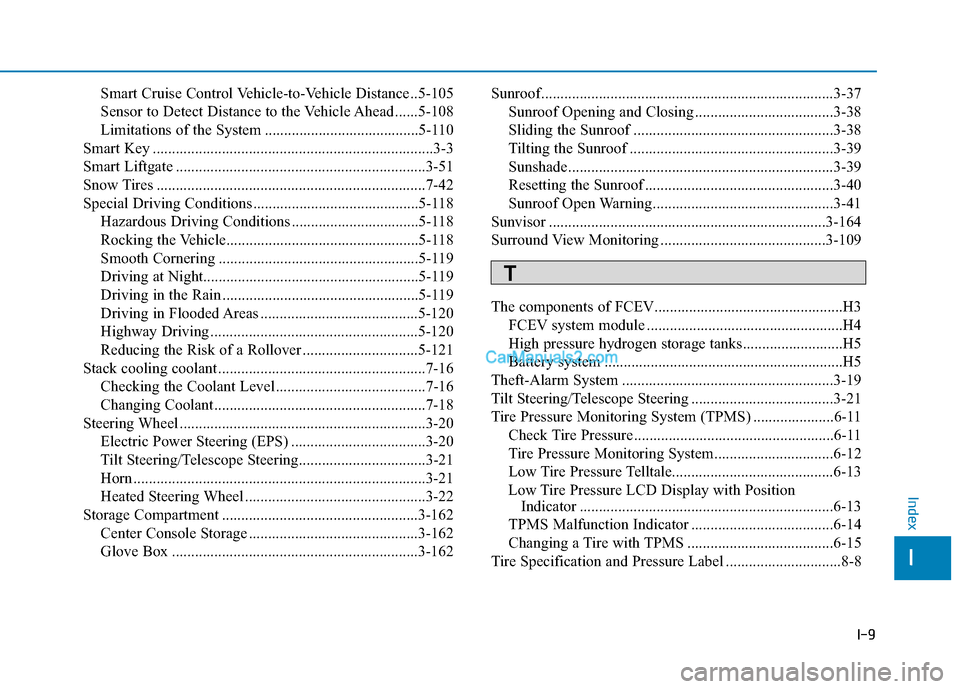
I-9
Smart Cruise Control Vehicle-to-Vehicle Distance ..5-105
Sensor to Detect Distance to the Vehicle Ahead ......5-108
Limitations of the System ........................................5-110
Smart Key ........................................................................\
.3-3
Smart Liftgate .................................................................3-51
Snow Tires ......................................................................7-\
42
Special Driving Conditions ...........................................5-118 Hazardous Driving Conditions .................................5-118
Rocking the Vehicle..................................................5-118
Smooth Cornering ....................................................5-119
Driving at Night........................................................\
5-119
Driving in the Rain ...................................................5-119
Driving in Flooded Areas .........................................5-120
Highway Driving ......................................................5-120
Reducing the Risk of a Rollover ..............................5-121
Stack cooling coolant ......................................................7-16 Checking the Coolant Level .......................................7-16
Changing Coolant.......................................................7-18
Steering Wheel ................................................................3-20 Electric Power Steering (EPS) ...................................3-20
Tilt Steering/Telescope Steering.................................3-21
Horn ........................................................................\
....3-21
Heated Steering Wheel ...............................................3-22
Storage Compartment ...................................................3-162 Center Console Storage ............................................3-162
Glove Box ................................................................3-162 Sunroof........................................................................\
....3-37
Sunroof Opening and Closing ....................................3-38
Sliding the Sunroof ....................................................3-38
Tilting the Sunroof .....................................................3-39
Sunshade.....................................................................3-3\
9
Resetting the Sunroof .................................................3-40
Sunroof Open Warning...............................................3-41
Sunvisor ........................................................................\
3-164
Surround View Monitoring ...........................................3-109
The components of FCEV.................................................H3 FCEV system module ...................................................H4
High pressure hydrogen storage tanks..........................H5
Battery system ..............................................................H5
Theft-Alarm System .......................................................3-19
Tilt Steering/Telescope Steering .....................................3-21
Tire Pressure Monitoring System (TPMS) .....................6-11 Check Tire Pressure ....................................................6-11
Tire Pressure Monitoring System...............................6-12
Low Tire Pressure Telltale..........................................6-13
Low Tire Pressure LCD Display with Position Indicator ..................................................................6-13
TPMS Malfunction Indicator .....................................6-14
Changing a Tire with TPMS ......................................6-15
Tire Specification and Pressure Label ..............................8-8
I
Index
T